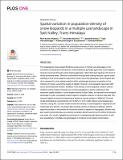Files in this item
Spatial variation in population-density of snow leopards in a multiple use landscape in Spiti Valley, Trans-Himalaya
Item metadata
| dc.contributor.author | Sharma, Rishi Kumar | |
| dc.contributor.author | Sharma, Koustubh | |
| dc.contributor.author | Borchers, David | |
| dc.contributor.author | Bhatnagar, Yash Veer | |
| dc.contributor.author | Suryawanshi, Kulbhushansingh R. | |
| dc.contributor.author | Mishra, Charudutt | |
| dc.date.accessioned | 2021-05-24T14:30:17Z | |
| dc.date.available | 2021-05-24T14:30:17Z | |
| dc.date.issued | 2021-05-19 | |
| dc.identifier | 274343994 | |
| dc.identifier | bac47872-73d6-477f-a424-e0c8887b91e4 | |
| dc.identifier | 85106362654 | |
| dc.identifier | 34010352 | |
| dc.identifier | 000664630900025 | |
| dc.identifier.citation | Sharma , R K , Sharma , K , Borchers , D , Bhatnagar , Y V , Suryawanshi , K R & Mishra , C 2021 , ' Spatial variation in population-density of snow leopards in a multiple use landscape in Spiti Valley, Trans-Himalaya ' , PLoS ONE , vol. 16 , no. 5 , e0250900 . https://doi.org/10.1371/journal.pone.0250900 | en |
| dc.identifier.issn | 1932-6203 | |
| dc.identifier.other | Jisc: 6017be32036d4416ae22c85a2bf4b392 | |
| dc.identifier.other | publisher-id: pone-d-20-32373 | |
| dc.identifier.other | ORCID: /0000-0002-3944-0754/work/94669415 | |
| dc.identifier.uri | https://hdl.handle.net/10023/23240 | |
| dc.description | Funding: The body of work in the manuscript is based on primary funding from the following three donors: 1. CM: Whitley Fund for Nature, www.whitleyaward.org; 2. RKS: Snow Leopard Network www.snowleopardnetwork.org; and 3. RS: Panthera, www.panthera.org We do not have any grant numbers. | en |
| dc.description.abstract | The endangered snow leopard Panthera uncia occurs in human use landscapes in the mountains of South and Central Asia. Conservationists generally agree that snow leopards must be conserved through a land-sharing approach, rather than land-sparing in the form of strictly protected areas. Effective conservation through land-sharing requires a good understanding of how snow leopards respond to human use of the landscape. Snow leopard density is expected to show spatial variation within a landscape because of variation in the intensity of human use and the quality of habitat. However, snow leopards have been difficult to enumerate and monitor. Variation in the density of snow leopards remains undocumented, and the impact of human use on their populations is poorly understood. We examined spatial variation in snow leopard density in Spiti Valley, an important snow leopard landscape in India, via spatially explicit capture-recapture analysis of camera trap data. We camera trapped an area encompassing a minimum convex polygon of 953 km2. Our best model estimated an overall density of 0.5 (95% CI: 0.31–0.82) mature snow leopards per 100 km2. Using AIC, our best model showed the density of snow leopards to depend on estimated wild prey density, movement about activity centres to depend on altitude, and the expected number of encounters at the activity centre to depend on topography. Models that also used livestock biomass as a density covariate ranked second, but the effect of livestock was weak. Our results highlight the importance of maintaining high density pockets of wild prey populations in multiple-use landscapes to enhance snow leopard conservation. | |
| dc.format.extent | 14 | |
| dc.format.extent | 1614270 | |
| dc.language.iso | eng | |
| dc.relation.ispartof | PLoS ONE | en |
| dc.subject | Research Article | en |
| dc.subject | Biology and life sciences | en |
| dc.subject | Earth sciences | en |
| dc.subject | Ecology and environmental sciences | en |
| dc.subject | Physical sciences | en |
| dc.subject | QA Mathematics | en |
| dc.subject | QH301 Biology | en |
| dc.subject | QL Zoology | en |
| dc.subject | General | en |
| dc.subject | NDAS | en |
| dc.subject | SDG 15 - Life on Land | en |
| dc.subject.lcc | QA | en |
| dc.subject.lcc | QH301 | en |
| dc.subject.lcc | QL | en |
| dc.title | Spatial variation in population-density of snow leopards in a multiple use landscape in Spiti Valley, Trans-Himalaya | en |
| dc.type | Journal article | en |
| dc.contributor.institution | University of St Andrews. School of Mathematics and Statistics | en |
| dc.contributor.institution | University of St Andrews. Statistics | en |
| dc.contributor.institution | University of St Andrews. Scottish Oceans Institute | en |
| dc.contributor.institution | University of St Andrews. Centre for Research into Ecological & Environmental Modelling | en |
| dc.contributor.institution | University of St Andrews. Marine Alliance for Science & Technology Scotland | en |
| dc.identifier.doi | 10.1371/journal.pone.0250900 | |
| dc.description.status | Peer reviewed | en |
This item appears in the following Collection(s)
Items in the St Andrews Research Repository are protected by copyright, with all rights reserved, unless otherwise indicated.

